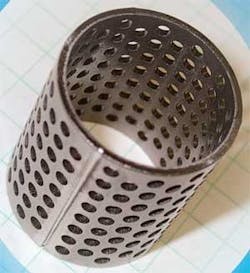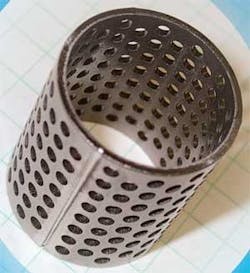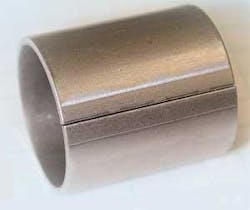Laser welding airbag components
Andrew Dodd
Quality and throughput are optimized in laser welding with SuperModulation
Optimizing or developing a production welding process has many phases. It starts with material choices and weld-joint design, proceeds through welding technology options and weld-schedule development, and ends with fixture optimization, material handling, and weld machine controls on the production system.
Many system requirements can be at odds with one another-for example, the tight fit-up of the weld joint versus high-speed, low-cost tooling or fast welding speed versus a more economical, lower-power laser. These issues and many more are considered throughout any project. In today’s fast-paced development of new products and concurrent engineering, it is always best to have the most flexibility and capability available at the lowest cost.
In the welding-system development outlined here, Oberg Industries, a manufacturer of precision stamped components for a variety of industries, including automotive, medical, and aerospace, with a reputation for highly accurate finished parts, was able to take its process and machine knowledge and use it to develop an economical welding system. This was made possible through the use of a laser system with a novel feature-SuperModulation.
The problem
An automotive customer had problems with the quality of the weld on one of its airbag components, supplied by another manufacturer. The supplier was using a conventional tungsten inert gas (tig) welding process, which wasn’t producing the reliability necessary for the component.
Oberg was able to help improve the part accuracy and quality using its stamping expertise, but the customer also wanted a completely and reliably welded tube. This is when Oberg began considering the possibility of using a laser. At its facilities in Sarver, near Pittsburg, PA, Oberg experimented with welding using a low-power pulsed Nd:YAG laser. Oberg’s customer was impressed with the results in terms of visual appearance and strength but found the process to be too slow.
Oberg approached GSI Group, Laser Division, and asked if it could use the company’s application laboratory to investigate the speed improvement that would be possible. For this task Oberg requested a laser source that could produce a weld speed of about 50 mm/s and that could meet the strength requirements of the customer.
The part in question is a 1008 carbon-steel perforated debris screen tube with a nominal thickness of about 1.2 mm. Beginning as a flat metal strip for hole punching, the plate is formed into a tube with a gap of about 1.0 mm to allow for seam alignment and location before welding. The quality criteria include good cosmetic surface and root appearance; the weld must withstand an oversize ball forced through the tube. This test is carried out on a periodic basis in production.
The initial task was to determine the proper laser source and welding technique in prototype parts. Discussions between GSI and Oberg determined that, though a 1-kW continuous-wave (cw) Nd:YAG laser would easily achieve the 50-mm/s welding rate, the project would not be economically viable. A 500-W laser would be a much better fit to the budget.
Prototype parts were welded in July of 2006 with a JK501SM Nd:YAG laser with both cw and supermodulated output. Welds were produced in solid tube parts without any perforations. Welding speeds and parameters were varied to achieve different penetrations and test their strength.
Supermodulated output produces higher peak powers from the laser in sine-wave and square-wave waveforms with a peak power of up to two times the laser’s rated power, while still producing the full rated mean power from the laser. This produces up to 40% higher welding speeds and much lower heat input than cw-only output. These benefits are provided by greatly reducing the amount of laser energy scattered by the soot that exists just above the weld pool during welding. Continuous-wave output produces a constant high soot level above the weld that begins a few milliseconds after the weld is initiated. This soot has a particle size that scatters and diffuses the beam away from the focus point, creating a larger weld width and lower penetration.
When using the periodic, higher-peak-power sine- or square-wave waveform of SuperModulation, the laser energy is delivered in the few milliseconds before the soot level rises to appreciable scattering levels. During the low energy cycle of the modulation, the soot level decays just as quickly to near zero levels when the process begins again with the next cycle. This effect occurs regardless of the laser power level or the beam quality of the laser. Cross sections of welds in cw-, sine-, and square-wave modulation clearly show the improvements in weld penetration.
From this work Oberg chose the smoothest welds run at 500 W cw and with a welding speed of 50 mm/s and 100% weld penetration with a 100-mm focal lens and focus spot size of 300 μm. These initial parts were loaded into a simple vise and pushed together until the gap was closed. Argon shield gas was delivered with a side jet.
More welding trials were carried out throughout 2006, as the part design developed and the production tooling became available. In all cases, the laser process was consistent with parts hand-loaded into the fixture and pressed together with the vise.
Working out the problems
Once the laser system arrived at Oberg and laser welding began on the system, some problems were encountered relating to the transfer from prototype welding to automated production welding. The gap in the seam of the butt weld showed some inconsistency due to the variations in part location and spring force. Shield-gas delivery design for the production fixture had not been tested, and welded parts were not passing the customer’s mechanical tests. Welding speeds were reduced to 23 mm/s to attempt to achieve proper weld strength.
Upon review, it was found that the gap that was observed in some fixtured parts and the variation in weld position resulted in energy lost in the weld gap and laser welds that were not centered well enough. Increasing the focus lens focal length increased the focus spot size and eliminated the gap-related problems.
To increase welding speed back to the 50-mm/s level used to justify the system, the laser parameters were changed to square-wave SuperModulation. This created faster welding, with the capability of dealing with the 20% increase in focus spot size. Finally, to achieve welds with enough strength and ductility, the argon-shield-gas delivery had to be optimized for the weld fixture to maintain very low oxygen content over the weld during the process and cool down.
Final parameters were 50 mm/s, square-wave SuperModulation at 300 Hz, 900-W peak power, and a 360-μm focus spot size with argon shield. The use of SuperModulation at 500-W average power gave this system the ability to compensate for weld-seam variations that were difficult to anticipate during the prototype phase of this project, allowing the concurrent engineering of the part and the process with low-cost, medium-power, Nd:YAG laser technology.
At the culmination of the process, Oberg was able to obtain a part welded to the required strength but at lower power than anticipated. The use of a 500-W cw laser with SuperModulation not only helped give Oberg the speeds it required at a price it could afford, but also had the process capacity to maintain welding speed and quality in production when all the process tolerances have to be tackled. It’s estimated that Oberg saved about $100,000 on machine costs by using this method.
Oberg is pleased with the result, which has allowed it to acquire new business and has also given the company the ability to offer an entirely new manufacturing process to existing and future customers.
Andrew Dodd is the North American director of sales and service for GSI Group Laser Division (Novi, MI, USA; www.gsiglaser.com).


